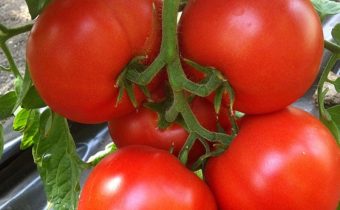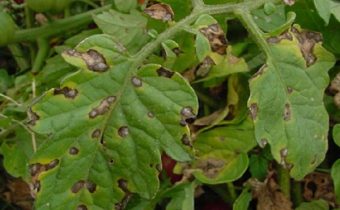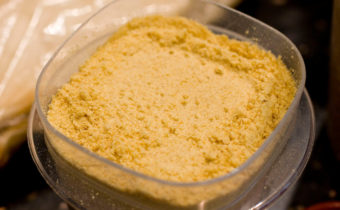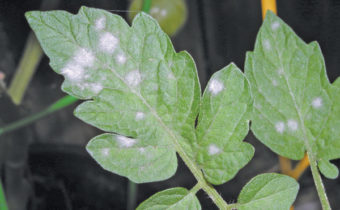Water the seedlings of tomatoes correctly so that it is strong and does not stretch.
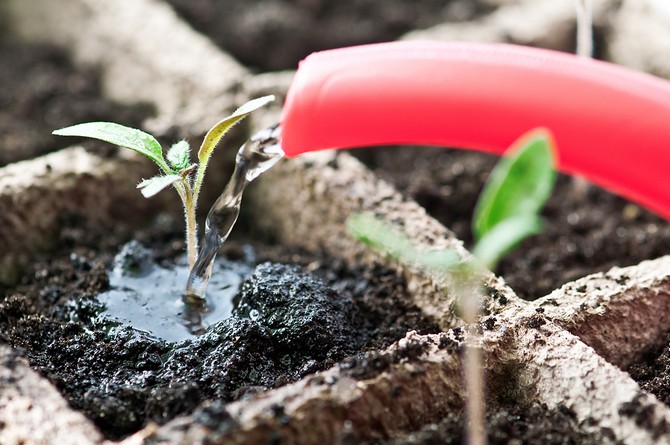
To get healthy and chunky tomato seedlings, it is important to know the finer points of watering. For beginner gardeners who are not yet knowledgeable in this matter, the question always arises: “How often should you do this?”. And for good reason, in fact competent watering gives a fertile harvest. Each stage of the seedling life has its own requirements for the presence of moisture in the soil and its own characteristics.
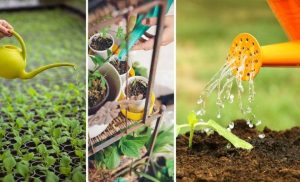
Watering after sowing seeds in the ground
Before sowing, the soil is well moistened with warm water. Then tomato seeds are laying and sprinkled on top of dry soil. Capacity covered with a film or glass, thereby creating greenhouse conditions. It is not necessary to water before the first shoots.
Important!
Care must be taken to keep the film wet, i.e. condensation has formed.
Watering after the appearance of the first shoots
After emergence of shoots the film is removed. Tomatoes, in the first 2-3 days, do not water, because the sprouts have enough moisture from the soil that was originally moist. Further watering should be depending on how quickly the earth dries. Watering is carried out at the very root of the germ, avoiding droplets on the leaves.
Important!
Take enough water to soak the soil to the full depth. Further watering is carried out only when the top layer of soil is completely dry.
Watering after picking
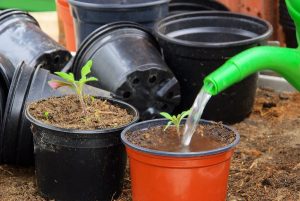 2 days before the scheduled day of the picking, seedlings should be watered. By this time, the ground will dry, but it will still be wet. 5 days after transplanting produce the first watering. Then it is carried out every 7 days.
2 days before the scheduled day of the picking, seedlings should be watered. By this time, the ground will dry, but it will still be wet. 5 days after transplanting produce the first watering. Then it is carried out every 7 days.
It is recommended to use the pallet for these purposes, as the roots will reach for moisture and grow rapidly, and the root system will become more powerful and strong. Water that is not absorbed through the drainage holes in the tank is drained after a couple of hours.
Watering after planting seedlings to a permanent place
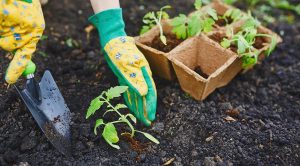 On the windowsill seedlings grow about 45-50 days. Plant growth reaches 30 centimeters in height, after which they are transplanted into open soil or a greenhouse. It is desirable to transplant on an overcast day - tomatoes will take root better.
On the windowsill seedlings grow about 45-50 days. Plant growth reaches 30 centimeters in height, after which they are transplanted into open soil or a greenhouse. It is desirable to transplant on an overcast day - tomatoes will take root better.
Before planting, seedlings are watered and allowed to infuse for 2 hours, this reduces the risk of damage to the root system. The soil in which the landing will be carried out, moisturize. Seedlings do not water 2 weeks, it protects the roots from leaching, and they take root sooner.
In the future, the plants before flowering watered every 5-6 days with warm water. Use 5 liters of water per square meter. Watering should be at the root of the germ, trying not to fall on the leaves with water.
During the flowering period, the saplings are watered once every 4 days, increasing the volume of water to 15 liters per square meter. After the beginning of fruiting, the volume for tall varieties is reduced to 10 liters, and for short-growing varieties to 5 liters. This helps to avoid sour taste and cracks in the fruit. How to determine the lack of moisture in the soil?
- One of the common ways is tapping on the tank in which the seedlings are planted. If the ground is dry, the sound will be ringing, and when the ground is wet, the side wall of the tank will sound muffled.
- There is another, less secure way. You can poke the soil with a stick or touch your finger on the edge of the container.Experienced gardeners determine the soil moisture, just by looking at it. If it has a pale brown color, then you need to moisten it, and if the color is dark brown, then water is enough. But you can make a mistake: the top layer of soil can already dry, and the rest will still be wet. In case of an error there is a danger to pour tomatoes.
- Very rough option - to raise the capacity. Dry soil is much easier than wet. It is impossible to give one hundred percent instructions on how often and in what quantity it is necessary to moisten the soil. This knowledge comes with time, you need to try and experiment.
The main mistakes when watering seedlings of tomatoes
Many newcomers are faced with gross errors that can lead to diseases of the tomato, and in the worst case, even death.
- The most common mistake is the selection of containers without drainage holes. In this case, you can inadvertently flood the plants, because excess water has nowhere to go.
- Use too cold and not filtered water. Not settled water contains harmful impurities and elements that can harm plants. Cold water leads to the formation of a black leg.
- Excess moisture. Tomatoes are moisture-loving plants, but they can start to rot from a large amount of moisture.
- Watering seedlings before diving. Plants are more difficult to tolerate planting if they are watered.
- As in the case of oversupply, irregular watering and lack of water has a bad effect on the health of tomatoes.
- Dry soil when transplanting to open areas. If you do not water the soil before transplanting, you can injure the root system of plants.
- Watering sprouts the first days after diving. Saplings will be harder to root, due to soil erosion.
Rules and Tips
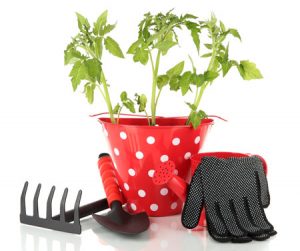 When performing watering is recommended to adhere to some rules to achieve maximum effect. Below is a list of recommendations that should be considered when performing irrigation.
When performing watering is recommended to adhere to some rules to achieve maximum effect. Below is a list of recommendations that should be considered when performing irrigation.
- A stream of water should be directed only at the root, it is best to use a watering can. Avoid the formation of droplets on the leaves. They work like lenses through which plants can get burned in the sun.
- In order not to accidentally flood the tomatoes, it is recommended to make drainage holes in containers.
- The optimal time for watering is cloudy weather and evening hours. In the morning the plants are more vulnerable.
- Use a drip for watering, it helps monitor soil moisture and stimulates root growth.
- It is best to water the tomatoes with rainwater. Tap water needs to be filtered and allowed to infuse in a dark room.
- It is not necessary to moisten the earth with a spray gun, it can create a false impression about the moisture of the bottom layer of soil.
- You can use liquid fertilizer once a month.
- If indoors heat, should increase the amount of water and the amount of watering.
The beneficial properties of tomatoes have been known for a long time: a storehouse of vitamins and microelements, reducing the risk of tumor formation, benefits in diabetes and kidney diseases, improving metabolism. In addition to all the above, the fruits are also very tasty!
Following these simple rules, small sprouts will eventually turn into strong plants and bring a bountiful harvest of tomatoes!



